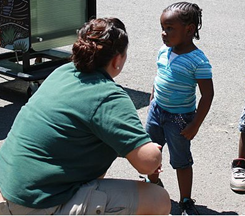8.2: Guiding Principles for Supporting Language and Literacy
It is critical that teachers and caregivers be responsive to young children’s attempts at communication and language by focusing on things that are meaningful to the children and their families. No single component of any curriculum will have more impact on a preschooler’s development than language.

Preschool is also an exciting time for written language development and for promoting interest in reading. If the social and physical environments in preschool and the home support the development of reading and writing, children will want to hear stories from books and to use books to find out more about things of interest. They will also be inclined to create marks that approximate letters and to learn how to write their own names. They will enjoy playing with the sounds of language as well. All of these experiences are foundations for the conventional reading and writing that come later.
Here are some guiding principles on how to support children’s language and emerging literacy:
- Language and literacy work together. They often occur in the same context. And having well-developed oral language contributes to later success with more formal reading and writing.
- The more language children hear, the more their language grows.
- It is important to give children rich models of speech/communication and reading and writing.
- Opportunities to learn language and literacy are everywhere.
- Children learn best from experiences that are interesting, useful, and fun. This includes silly songs, poems with surprise endings, and interesting and informative books.
- Celebrate and support the individual. Things such as temperament, prior experience, and disabilities affect children’s starting places with language and literacy.
- Connect with families. Providing them with certain materials and strategies to support their children’s language and literacy development benefits children’s learning.
- Create a culturally sensitive environment. Some children have been encouraged to speak up more than others.
- Encourage children to use language for negotiating with other children, asking for what they want, and expressing their emotions.
- Create many opportunities for children to do the talking. Ask open-ended questions and model engaging in the back-and-forth of conversations.
- Make thoughts more explicit to children by thinking out loud.
- Support curiosity and confidence. Children should freely use “Why? and “How come?”
- Create well-organized, literacy-rich environments, both indoors and outdoors.
- Observe how children engage with language and literacy to meet each child’s needs.[1]
- The California Preschool Curriculum Framework, Volume 1 by the California Department of Education is used with permission ↵

